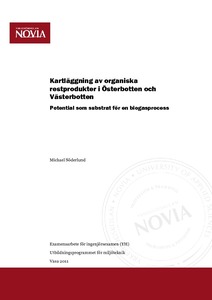Kartläggning av organiska restprodukter i Österbotten och Västerbotten : potential som substrat för en biogasprocess
Söderlund, Michael (2011)
Söderlund, Michael
Yrkeshögskolan Novia
2011
All rights reserved
Julkaisun pysyvä osoite on
https://urn.fi/URN:NBN:fi:amk-201105056187
https://urn.fi/URN:NBN:fi:amk-201105056187
Tiivistelmä
Examensarbetet utgör en del av Botnia Atlantica projektet ”Från bioavfall till bionäring–hållbara kretslopp med rötning och gödsling”. Rötresten som är en restprodukt från biogasframställning är ett attraktivt gödselmedel på många vis. Nya biogasanläggningar byggs nu i snabb takt i Botnia Atlantica-området, vilket innebär en ökad produktion av rötrest. Genom att gödsla skogen med rötrest från biogasanläggningar kan en ökad trädtillväxt erhållas, vilket medför ekonomiska samt miljömässiga fördelar. Rötresten måste hursomhelst optimeras ur näringssynvinkel och detta uppnås lättast genom samrötning av näringsrika substrat. Examensarbetet Kartläggning av organiska restprodukter i Österbotten och Västerbotten–potential som substrat för en biogasprocess, är en sammanställning av information som beskriver vilken potential fem färdigt givna organiska restprodukter har som substart för en biogasprocess samt hur de påverkar rötresten. De restprodukter som har undersökts är svin- och nötgödsel, växthusrester, fiskrens och slakteriavfall. Vad som har undersökts är uppkomsten av respektive restprodukt i Österbotten och Västerbotten samt dess tillgänglighet för en biogasanläggning. Utöver detta har även restproduktens karaktär, hygien och röttekniska egenskaper undersökts. Metoderna som använts har varit intervjuer med producenter samt expertis, provtagningar, studier av statistik samt studier av litteratur och lagstiftning. Resultatet av kartläggningen var att tillgängligheten på de näringsrikaste och därmed attraktivaste restprodukterna var dålig. Den dåliga tillgängligheten berodde främst på att producenterna redan hade goda användningsmöjligheter för restprodukterna. My Bachelor´s thesis is part of the Botnia Atlantica project “From biowaste into organic nutritions–sustainable cycles with anaerobic digestion and fertilization.” The nutrient rich digestate that is the residue of biogas production is an attractive fertilizer in many ways. New biogas plants are being built at a rapid pace in the Botnia Atlantica region, which means an increased production of digestate. By fertilizing the forest with digestate from biogas plants, an increased tree growth can be obtained, which has economic and environmental benefits. The digestate must however, be optimized from a nutritional point of view, and this is best achieved through co-digestion of nutrient rich substrates. The Bachelor´s thesis Mapping of organic residues in Ostrobothnia and Västerbotten–potential as a substrate for a biogas process, is a compilation of information that describes the potential of five already determined organic residues as substrates for a biogas process and how they affect the digestate. The residues that have been examined are pig and cattle manure, greenhouse residue, fish trimmings and slaughterhouse waste. What has been investigated is the occurrence of each residue in Ostrobothnia and Västerbotten, and their availability for a biogas plant. The nature of the residues, hygiene and anaerobic digestion properties were also investigated. The methods used were interviews with producers and expertise, sampling, study of statistics and studies of literature and law. The result of the mapping was that the availability of the nutrient rich and therefore most attractive residues was poor. The poor availability was mainly due to the fact that producers already had good uses for their waste products.
